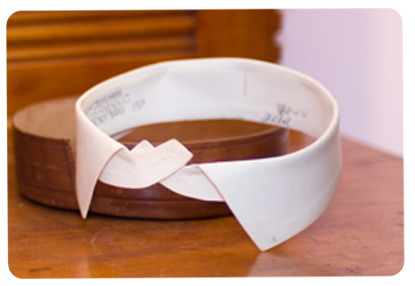
19th Century
America
Linen, cardboard, composite materials, and ink
Eugene Field House Museum
Descriptive Detail
White collars, with a stitched leather box to keep them, sit on the dresser at the Eugene Field House. Approximately two and one-quarter inches high, starched and stiff, these strips of fabric shaped into circles are detachable—shirt collars that separate from the shirt but are fastened to it by studs. Made of linene, linen laminated to cardboard, these particular collars are an example of the popular turn-down style that Eugene Field would have worn to the newspaper office, but not to a formal dinner party. The collars have “Field” written inside, indicating that they were probably sent out to a laundry.
Local Historical Connections
Collars such as these would be fairly easy to sew either by hand or by machine. They could have easily been a project that a young girl might have made on her sewing machine. It was also an item that could provide employment to any competent seamstress. The examples here however, are ready-made and store-bought. A logo, neck size, and other information is printed on the inside of each collar.
Detachable collars were an important wardrobe item for men because they helped preserve shirts and extend wardrobes. During a large part of the nineteenth century, almost all clothing was both handmade and expensive so most people did not have large wardrobes. Since men usually wore undershirts, the places of most contact between skin and shirt were at the collar and the cuffs. By making removable collar and cuffs that could be washed separately, the shirt would not need to be washed as often and therefore would last longer.
National Historical Connections
The detachable collar was invented in 1827 by Hannah Lord Montague, a housewife in Troy, New York, who was tired of trying to remove the “ring-around-the-collar” from her husband’s shirts. To have a collar that was separate from the shirt was not only more efficient for laundering, but it was also more economical because it allowed the soiled collar to be replaced without having to buy an entirely new shirt. Rev. Ebenezer Brown, a businessman in town, proceeded to commercialize it. The manufacture of detachable collars became a significant industry in Troy. Initially made by hand and constructed of cotton, paper, or heavily starched linen, the collar’s popularity quickly spread to the rest of the world, particularly among the growing class of office workers who became known as “white collar” workers. Detachable collars were the height of fashion by 1862 when machines were invented to mass produce them by laminating linen onto thick cardboard stock creating a material known as linene. Shortly after its invention in 1870, an early form of plastic called celluloid was interlined with the linen to create a very stiff collar that could be cleaned with soap and water instead of the elaborate starching and pressing process required for pure cotton and linen.
By the turn of the century the most popular collar styles were turndown (fold), poke (upright), spread, and wing. Like the stiff-front shirt, the hard collar became unpopular during World War I when men became accustomed to the soft attached collars worn with their military uniforms. Once the factories started making clothing in mass production, which made clothing less expensive and more available, the separate collar and cuff didn’t save time or resources anymore.
top^
next artifact}
|

|



